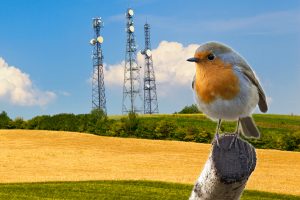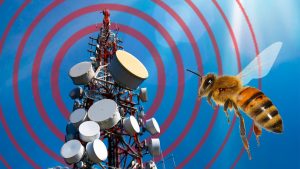In this presentation from our video series “How artificial electromagnetic radiation harms life”, the focus is on plants, and animals from mammals to birds and insects. The video uses a variety of research results to explain how continuous radiation affects animals and plants. It also shows why the new wireless standard 5G in particular will significantly increase exposure.
Along with the video, we also provide you with an article containing this information, and which explains why we usually learn little about these effects of electromagnetic radiation on animals and plants.
Since the founding of The World Foundation for Natural Science, we have been campaigning for the responsible use of wireless technologies and reporting on their effects. If you have been following our newsletters and publications, you already know that the technical radiation currently used endangers human health. But what about the rest of nature and our environment? From time to time there are critical reports about how bees and insects are affected by radiation. However, rarely are other animals or even plants reported on, although numerous studies have already been carried out on this. Read below how electromagnetic radiation affects the entire animal and plant world and why something urgently needs to change if we want to maintain a functioning ecosystem on this planet.
At the beginning, three selected studies are reported and then the findings are summarised for different animal groups and plants. It explains why 5G will have an even more detrimental impact on life than the wireless technologies currently in use and why we hear so rarely about it in the public media.
By using the links below you can also jump directly to the chapters that interest you most.
- Toxins in the rat brain
- Disoriented migratory birds
- Beeping bees
- Effects of technical radiation on mammals
- Effects of technical radiation on birds
- Effects of technical radiation on amphibians and reptiles
- Effects of technical radiation on insects
- Effects of technical radiation on plants
- How will 5G radiation affect animals and plants?
- Why is this not reported?
- Summary
Toxins in the rat brain
Dr. Leif Salford did research for the pharmaceutical industry at Lund University in Sweden in the early 1990s with the task of finding a way to get certain pharmaceutical substances through the blood-brain barrier so that they could act in the brain. The function of the blood-brain barrier is to protect the brain from toxic and harmful substances. After making no progress in his research on rats for a long time, Salford one day succeeded in identifying the substances in the brains of a group of his experimental animals. At first he could not understand why this had worked in these animals in particular, because he had not treated them differently from the other rats. But then it became clear to him. The only thing he had done differently that day was that he had left his new mobile phone next to the rats’ cage. After a series of follow-up experiments, he was able to provide the frightening proof in 1992: The radiation from an ordinary mobile phone is enough to make the blood-brain barrier permeable to albumin and other, smaller, molecules, which can then cause damage in the brain (Persson & Salford 1992). After a series of further studies, Salford came to the conclusion, most recently in 2002, that irradiation for 2 hours below the German limits already deactivates the blood-brain barrier (Salford et al. 2002).
Disoriented migratory birds
 Henrik Mouritsen is researching animal behaviour at the University of Oldenburg, including the migratory behaviour of robins. The experiments do not take place with birds in the open air, but with robins in cages. The bowl-shaped cages are lined with special paper on which the birds’ tracks become visible. Even though the birds cannot fly south during migration season, they still keep fluttering up towards the south in the bowl-shaped cages and slide back down to the centre, leaving traces on the coloured paper. Even though this method does not seem very pleasant for the bird, it is an established scientific method used to compare the timing and intensity of migratory behaviour in small migratory birds. On the campus of the University of Oldenburg, it was noticed one day that the birds could no longer orient themselves during migration and did not show a clear direction of migration. A doctoral student of Prof. Mouritsen came up with the idea of shielding the small houses in which the experiments took place from electromagnetic radiation by purely experimenting with magnetic fields. And lo and behold, suddenly the migratory birds could orientate themselves again and showed normal migration behaviour. By shielding the house, the researchers were able to control whether the birds could perceive the earth’s magnetic field and orient themselves or not. Due to the technical properties of the shielding, the scientists concluded that it was mainly radio waves that could be shielded and that these had prevented the migratory birds from perceiving the Earth’s magnetic field (Engels et al. 2014).
Henrik Mouritsen is researching animal behaviour at the University of Oldenburg, including the migratory behaviour of robins. The experiments do not take place with birds in the open air, but with robins in cages. The bowl-shaped cages are lined with special paper on which the birds’ tracks become visible. Even though the birds cannot fly south during migration season, they still keep fluttering up towards the south in the bowl-shaped cages and slide back down to the centre, leaving traces on the coloured paper. Even though this method does not seem very pleasant for the bird, it is an established scientific method used to compare the timing and intensity of migratory behaviour in small migratory birds. On the campus of the University of Oldenburg, it was noticed one day that the birds could no longer orient themselves during migration and did not show a clear direction of migration. A doctoral student of Prof. Mouritsen came up with the idea of shielding the small houses in which the experiments took place from electromagnetic radiation by purely experimenting with magnetic fields. And lo and behold, suddenly the migratory birds could orientate themselves again and showed normal migration behaviour. By shielding the house, the researchers were able to control whether the birds could perceive the earth’s magnetic field and orient themselves or not. Due to the technical properties of the shielding, the scientists concluded that it was mainly radio waves that could be shielded and that these had prevented the migratory birds from perceiving the Earth’s magnetic field (Engels et al. 2014).
Beeping bees
Daniel Favre has been researching the behaviour of honey bees for decades and knows about the sensitivity of these insects to electromagnetic fields, because they also orient themselves to the Earth’s magnetic field, among other things, and sense changes in the weather caused by electromagnetic fields long before humans notice a change. Favre was already able to prove in 2011 that bees emit distress signals (worker bee beeps) when irradiated with a mobile phone, which they otherwise only produce when attacked by birds or other insects or shortly before they want to abandon their colony and swarm out (Favre 2011). The evidence that bees sense, respond to and are stressed by mobile phone radiation was thus provided.
Nevertheless, critics claimed that radiation from a mobile phone at close range was not a realistic situation for bee colonies and that Favre’s results were therefore negligible. In his latest research, however, Daniel Favre shows that bees also react to technical radiation without a mobile phone being nearby. Favre placed his microphones in the bee hives and started the recordings during the change of year. Although there was no source of radiation close by, the bees also reacted with their worker bee beeping, and not only during the period of the turn of the year in Switzerland, but also when the turn of the year was rung in large cities in other time zones, although these events took place thousands of kilometres away.
 What was the cause of this?—Have you ever tried to call a friend at the turn of the
What was the cause of this?—Have you ever tried to call a friend at the turn of the
year to wish them a Happy New Year and you couldn’t connect? Haven’t you also received text messages and New Year’s wishes hours or days later? If so, you are one of the millions of people who can confirm that mobile phone networks are extremely overloaded on New Year’s night, especially between 0:00 and 1:00 a.m., and consequently the radiation exposure also increases very strongly. The bees are so sensitive to fluctuations in the earth’s electromagnetic field that they sense the changes caused by mobile phone radiation, even if they are caused thousands of kilometres away in another country. These disturbances could be fatal for bees in winter, when they leave their natural, warming, protective cluster, and, due to stress and confusion, get an increased need for food or even leave the hive and then freeze to death in the cold winter night (Favre 2020).
The three examples show that representatives of the animal groups mammals (rats), birds (robins) and insects (honey bees) react very sensitively to electromagnetic fields generated by humans. Just because most humans do not perceive radiation directly does not mean that this applies to other living creatures as well. In addition to the examples described, there are a number of other disturbing findings for animals and plants, which are summarised below for various groups.
Effects of technical radiation on mammals
 In an experiment on mice in Greece, it was already shown in 1997 that mice become completely infertile within 3 generations with permanent irradiation of only 1/30 of the German limit values (Magras and Xenos 1997). In a study by the US National Toxicology Program (NTP), 360 rats were irradiated with mobile phone frequencies for life (Wyde et al. 2018). At the Ramazzini Institute (Falcioni et al. 2018), more than 2000 rats were irradiated for 2 years each. Here, too, the limit values were adhered to, thus creating situations to which we humans are also exposed. In both studies, there was clear evidence of an increase in malignant tumours in the group of irradiated animals.
In an experiment on mice in Greece, it was already shown in 1997 that mice become completely infertile within 3 generations with permanent irradiation of only 1/30 of the German limit values (Magras and Xenos 1997). In a study by the US National Toxicology Program (NTP), 360 rats were irradiated with mobile phone frequencies for life (Wyde et al. 2018). At the Ramazzini Institute (Falcioni et al. 2018), more than 2000 rats were irradiated for 2 years each. Here, too, the limit values were adhered to, thus creating situations to which we humans are also exposed. In both studies, there was clear evidence of an increase in malignant tumours in the group of irradiated animals.
After a mobile phone antenna was installed on the barn, there was a 3.5-fold increase in severe cataracts of the eyes in a Swiss cattle farm compared to the time before,
also known as (the German) “Grauer Star” (Hässig et al. 2009). In a German farm (Buchner et al. 2014), problems arose in pig breeding after the installation of a mobile phone base station in 2009. The number of litters and piglets decreased significantly, while the number of malformations increased. A connection with infectious diseases could not be established. The authors attribute the breeding problems to electromagnetic fields.
Effects of technical radiation on birds
In birds, too, there are many studies documenting harmful effects of mobile phone radiation on reproduction. As early as 1984, Prof. Dr. Andreas Varga at the University of Heidelberg found out that chicken embryos in eggs died within a few hours if they were irradiated with an intensity 20 times below the German limit. When the radiation intensity was attenuated, numerous malformations still occurred (Varga 1984).
In Spain, some studies were carried out on free-living birds and it was found that storks whose nests were closer than 200 metres from a mobile phone base station bred unsuccessfully and remained without offspring. At a distance of 200 to 300 metres the findings improved and from a distance of 300 metres 96.7% of the storks bred successfully (Balmori et al. 2005). Also in Spain, the sparrow population was studied in the city of Valladolid and it was found that the number of sparrows decreased where the electromagnetic radiation from mobile phone antennas reached certain elevated levels (Balmori et al. 2007). A similar study took place in Belgium at the same time. Here, too, a census was carried out in the vicinity of several mobile phone base stations during the breeding season of the house sparrow. It confirmed a significant relationship between the electric field strength of mobile phone radiation and the decline in the number of animals counted (Everaert et al. 2007).
Effects of technical radiation on amphibians and reptiles
The least research literature on electromagnetic fields is available for amphibians and reptiles. However, the two available experiments clearly complete the picture. Before the installation of a mobile phone mast, frog ponds were shielded from radiation with a Farraday cage, but other ponds were not (Balmori 2010). Over two months, average exposures to radiation were between 1.8 and 3.5 V/metre (about 1/30 to 1/20 of the German limit). In the unshielded ponds, 90% of the larvae of frogs (Rana temporaria) died and their coordination and ability to move were impaired. In the screened ponds, mortality was only 4.2% and coordination and locomotor abilities developed normally.
The immune system of the wandering salamander (Podarcis erhardii) no longer functioned properly after eight weeks of irradiation with a DECT phone. Its immune response to inflammation was 45% weaker than under normal conditions (Mina et al. 2016).
Effects of technical radiation on insects
In addition to Daniel Favre, other scientists have also observed adverse effects on the behaviour of honey bees when these are exposed to technical radiation. When bee colonies are irradiated with base stations of DECT phones, the collecting bees need much more time to find their way back to the hive and some do not find it at all (Harst et al. 2006). The same effect was observed in India, where bee colonies were irradiated with mobile phones twice a day for 15 minutes each over a period of 2 months. The radiation exposure also resulted in fewer bees returning from their collection flights. As a consequence, there was a poorer food supply, fewer offspring and smaller colonies (Sharma and Kumar 2010). To find more clues as to why colonies shrink under irradiation, the Indian scientists tested how bee lymph, the bees’ blood, changes when the bees are exposed to mobile phone radiation: There was an increase in carbohydrates, fats, glucose, cholesterol and proteins—all evidence that the bees were exposed to extreme stress (Kumar 2011). For queen bees that were permanently irradiated with a mobile phone during the development phase, 44% died while still in the pupal stage (Odemer and Odemer 2019).
Even ants, which are very closely related to bees, have been shown to be affected by technical radiation. The ant species Myrmica sabuleti (sabre-thorned knot ant) was tested for its abilities to orientate itself through the senses of smell and sight and to remember smells and visual impressions (Cammaerts et al. 2012). In the result, ants that were irradiated with mobile radio could no longer remember what they had learned after only a few hours, whereas they can normally store this knowledge for several days. In a subsequent study (Cammaerts et al. 2013), it was found that the ants could only follow odour trails over short distances and no longer arrived at the marked locations. Many were unable to find their way back to the nest, causing the number of foraging ants to keep decreasing. After a week of irradiation, the colonies could no longer feed themselves and perished.
A study on the fruit fly shows that the ovaries of individuals exposed to mobile phone radiation are significantly smaller (Panagopoulos 2012). According to the scientists, this is a result of DNA damage and the death of cells in the egg chambers.
Since the cases documented to date mainly showed isolated effects on a few insect species, a large field trial was conducted in Greece to investigate whether the insect population of pollinators (wild bees, hoverflies, other flies, beetles, butterflies and wasps) changes under real conditions at different distances from a radio mast (Lazaro et al. 2016). For all insect groups mentioned, it was observed that over a distance of 50 to 400m, insect populations became smaller the closer one got to the radio mast. The authors of the study conclude that artificial electromagnetic fields have negative ecological and economic impacts on the conservation of wild plant diversity, plant production and human well-being.
Effects of technical radiation on plants
 In addition to the findings from the animal kingdom, there are also studies on how plants react to irradiation. After a forest with conifers had been irradiated by a mobile phone antenna for 222 days, the foresters recorded the proportion of dead trees of three tree species and compared them with another forest that had not been exposed to radiation. They found that three times as many dwarf pine (Pinus pumila) and grand fir (Abies grandis) trees and twice as many silver fir (Abies alba) trees had died than in the non-irradiated forest (Lerchl et al. 2000). A possible explanation for why trees react so extremely to radiation can be found in their structure. The many branches, twigs, needles and leaves act like antennas for the radiation, which means that they begin to resonate when a part of the tree is the same length as the wavelength of the frequency with which they are irradiated, and they thus absorb an extremely large amount of radiation energy. Under these conditions, metabolism and cell division probably no longer function as usual. Due to the work of Cornelia Waldmann-Selsam, Volker Schorpp and Helmut Breunig, there are hundreds of documented cases of damage to trees caused by radiation exposure. In most cases, the tips of the trees or parts of the crown that are exposed to a direct cone of radiation are damaged, as evidenced by the discolouration and shedding of needles and leaves. (Waldmann-Selsam & Eger 2013; Waldmann-Selsam et al. 2016; Breunig 2017).
In addition to the findings from the animal kingdom, there are also studies on how plants react to irradiation. After a forest with conifers had been irradiated by a mobile phone antenna for 222 days, the foresters recorded the proportion of dead trees of three tree species and compared them with another forest that had not been exposed to radiation. They found that three times as many dwarf pine (Pinus pumila) and grand fir (Abies grandis) trees and twice as many silver fir (Abies alba) trees had died than in the non-irradiated forest (Lerchl et al. 2000). A possible explanation for why trees react so extremely to radiation can be found in their structure. The many branches, twigs, needles and leaves act like antennas for the radiation, which means that they begin to resonate when a part of the tree is the same length as the wavelength of the frequency with which they are irradiated, and they thus absorb an extremely large amount of radiation energy. Under these conditions, metabolism and cell division probably no longer function as usual. Due to the work of Cornelia Waldmann-Selsam, Volker Schorpp and Helmut Breunig, there are hundreds of documented cases of damage to trees caused by radiation exposure. In most cases, the tips of the trees or parts of the crown that are exposed to a direct cone of radiation are damaged, as evidenced by the discolouration and shedding of needles and leaves. (Waldmann-Selsam & Eger 2013; Waldmann-Selsam et al. 2016; Breunig 2017).
A good summary of previous research with plants and mobile phone frequencies is provided by the study by Alain Vian (Vian et al. 2016).
In this review, 60 studies were evaluated in which plants were irradiated with frequencies in the range from 450 MHz to 2.4 GHz. The most frequently used plant species were radish, tomato, tobacco, beans, lentils, corn, roses and hybiscus. The results of all 60 studies paint a frightening picture. There were numerous impairments in cell metabolism, frequent abnormal cell division, 6 times more genetic damage, inhibition of seed germination in half of all cases, and reduced growth, height or weight of plants and fruits in the range of 16 to 60% compared to non-irradiated plants.
How will 5G radiation affect animals and plants?
With 5G (5th mobile phone generation) come new mobile phone frequencies with new characteristics regarding pulsation and frequency modulation.
As far as the frequencies of 5G are concerned, there is clear cause for worry. The wavelengths of the previous mobile phone generations were about 40 to 12 cm (frequencies from 0.7 to 2.4 GHz). This means that antennas with these lengths begin to resonate and receive the radiation optimally. Many branches and twigs of trees and bushes fall into this range, and as described, these also show a clear response. The planned 5G frequencies are much higher and are to be up to 100 GHz in the later expansion stages, which corresponds to wavelengths of a few centimetres to millimetres, which is why one also speaks of millimetre waves. They transport more energy than the lower frequencies, but also do not penetrate as deeply into the body. However, this means that in larger organisms such as humans, all the radiant energy is absorbed by the surface of the body such as the skin and eyes. In smaller organisms, the whole body is still penetrated. The magnitude of these wavelengths is in the range of leaves, needles and insects, which, from a purely physical point of view, will begin to resonate and be optimal antennas for the 5G radiation. Arno Thielens wanted to know more precisely and calculated how much radiation energy the insects absorb at these frequencies. Thielens was able to prove that all his insect models absorb more radiation energy at frequencies above 6 GHz and that the relationship is not linear, but exponential. This means that a 10% increase in radiant intensity leads not only to a 10% increase in the uptake of radiant energy by insects, but to up to a 370% (37-fold) increase in energy transfer (Thielens et al. 2018). Insects will thus feel the radiation even more strongly than before, they will be set into vibration and heat up. The fact that this means an impairment, if not the shutdown of bodily functions or can even lead to death, should be clear to everyone against the background of the effects of the already existing radiation on insects described above.

Let us now turn to the modulation techniques of mobile phone radiation. As early as 2004, Dimitris Panagopoulos found out that mobile phone radiation of the GSM signal (2nd mobile phone generation) reduced the reproduction of fruit flies (Drosophila melanogaster) by up to 60% (Panagopoulos et al. 2004). However, this extremely strong effect only occurred with modulated GSM signals, as they are generated by the transmission of call data during real mobile phone use. In the case of irradiation with unmodulated, “clean” GSM signals (i.e. only the pure carrier wave without data transmission), as often used in laboratory experiments, there was still an effect, but it was significantly smaller at 20% reduction in reproductive performance. In a summary study from 2015, the authors conclude that studies on brain tumours, general disease symptoms and insect populations with “real” (modulated) mobile phone signals always showed significantly more harmful effects than studies in the same frequency range with “clean” (unmodulated) mobile phone signals (Panagopoulos et al. 2015 and Panagopoulos et al. 2016). The researchers assume that the body is better able to protect itself with defence mechanisms against a constant harmful influence (unmodulated mobile phone signal) after a certain time than against a constantly changing influence (modulated mobile phone signal), against which new and different adaptation strategies would be necessary again and again. These results were confirmed in the report of the Scientific Advisory Board of the European Union from February 2020 (Karaboytcheva 2020). There, on the subject of pulsation, which is also a type of modulation technique, it states:
“Studies show that pulsed EMF (electromagnetic fields) are in most cases more biologically active and therefore more dangerous than non-pulsed EMF. Every single wireless communication device communicates at least partly via pulsations, and the smarter the device, the more pulsations. Consequently, 5G may be weak in terms of power, but its permanent artificial pulsed radiation can have an effect. Coupled with the type and duration of exposure, properties of the 5G signal, such as pulsation, appear to amplify the biological and health effects of exposure, including DNA damage, which is thought to be a cause of cancer.”
Not only does 5G use new frequencies and modulation techniques, the radiation is also expected to be built up all around the planet through the use of satellites. Habitats where animals and plants can live today still reasonably protected from human influence will also be irradiated as a result. There will be no place left where animals can retreat.
Common sense tells us that any additional radiation exposure will also cause more harm, if we realise, as reported above, what effects the already existing radiation exposure has on animals and plants. Another problem with the discussion about 5G is that no studies were done on the effects before its introduction, and thus the Precautionary Principle was disregarded. Anyone who warns against the new, untested 5G frequencies therefore quickly finds themselves in the position of not being taken seriously because no studies can be cited. In such cases, one can only recall the precautionary principle, which states that already when there is a suspicion of harm, radiation exposure must be suspended until it is proven that the radiation is harmless, which has also not yet happened.
Why is this not being reported?
Are you shocked by the results? Do you ask yourself why you have not heard anything about it until now and why mobile phone radiation has not been abolished long ago? We can best answer this question using the example of the literature study “Biological effects of electromagnetic fields on insects” by Alain Thill, which was published in September 2020 and commissioned by diagnose:funk and NABU Baden-Württemberg (Nature and Biodiversity Conservation Union). The study evaluates 83 scientific papers on the effects of technical radiation on insects and comes to the following conclusion (Thill 2020):
“It was found in some experiments that, despite low exposure to transmitters, harmful effects occurred after several months. Field strengths already 100 times below the ICNIRP limits could already have effects. It could be that harmful effects for insects occur at radiation intensities that are harmless for humans – especially in the higher frequency bands. Until the truth emerges, the development of the expansion should be closely monitored and toxicological tests should be started immediately to quickly identify and quantify any harmful effects so that realistic protective guidelines can be issued. Against the background of the rapid decline of insects and the further expansion of high-frequency electromagnetic field sources, there is not only an urgent need for further research, but also for interactions with other harmful noxious agents such as pesticides. When planning mobile phone expansion, insect habitats must already be protected from EMF exposure now.”
In the first weeks after its publication, the study was sharply criticised by very many institutions, newspapers and radio stations, which damaged its reputation and the handling of the whole issue. Diagnose:funk accepted the criticism and decisively responded to the accusations (diagnose:funk 2020), revealing in summary the following approach of the critics.
- Counter-studies are cited that found no effects of mobile phone radiation on insects. However, in the majority of cases, these studies used unmodulated mobile phone frequencies, which are clearly less harmful in their biological effectiveness, or they are studies that only look at such short periods of time that no damage can yet be measured, or these studies were financed by the mobile phone industry and are thus subject to a conflict of interest that could influence the result.
- Studies were clearly quoted out of context, i.e. sentences are only partially reproduced, which then speak for the harmlessness of radiation. However, these actually refer to very specific situations and conditions and cannot simply be generalised. Statements from the same studies that prove harmful influences are simply ignored.
- It is claimed that the number of available studies is not sufficient to judge whether electromagnetic radiation is harmful or not. However, those who claim this are precisely those who have failed for decades to follow the advice of their colleagues and conduct studies themselves. Their own covert inactivity and refusal to provide research funding is thus taken as an argument to prove that it is harmless.
- The methods of the studies are often criticised and, if the method is allegedly flawed, the entire results are called into question. On closer examination, however, it turns out that the methods used have been fully scientifically accepted for years on other issues. It also often becomes clear that the critics are actually not in a position to evaluate the methods of their colleagues because they themselves have never used these methods or even never worked in the field of the criticised study.
- It is demanded that the harmful effects found be explained down to the smallest detail physically and biochemically, i.e. causality is not acknowledged as long as the scientists cannot say by which processes at the molecular level the symptoms are caused. This demand for an explanation of causality is unique and is only claimed in the case of damage caused by mobile phone radiation, but not, for example, in the classification of carcinogenic substances.
This is just one example that shows the strategies the mobile phone industry uses to manipulate the public and to play down the results in order to make money with their technology for as long as possible. It took almost 70 years after tobacco smoke was first shown to cause lung cancer (Glantz et al. 1998) until this was publicly acknowledged and the Non-Smoker Protection Act was established in Germany in 2007. Today, there are many analyses of how the tobacco industry has managed to manipulate politicians, appease the public and suppress research results for 70 years. From downplaying to suppression of information and research, distraction, concealment, tokenism, sowing doubt, manipulation and corruption, to threats and life-threatening attacks on scientists, they have used whatever methods have served their purposes (Glantz et al. 1998; Helmert 2010). Do you really think that the mobile phone industry does not also take advantage of the tobacco industry’s findings? It does and we see it if we are observant enough. However, anyone who makes no effort to check the information we are given in the media will quickly be convinced that mobile phone radiation poses no health risk whatsoever.
Summary
There are many mechanisms by which electromagnetic radiation can harm living organisms. In the field of animals, it may be that sensory organs for electromagnetism (such as those possessed by bees, birds, whales and dolphins) perceive the technical radiation directly or are disturbed by it, and the animals thus lose their orientation. Another reason can be that certain parts of the body begin to resonate and thus can no longer fulfil their functions. Extreme heat can develop, which can lead to the coagulation of proteins and thus to damage and even death. Another possible cause is that certain organs or functions that are controlled via the nervous system with the help of electrical charges and voltages are activated or deactivated by the technical frequencies, such as the blood-brain barrier or the calcium channels of the cells.
The latter calcium channels are a key to understanding how harmful technical radiation is. Under radiation stress, the cells can no longer close these channels and calcium ions flow (Yakymenko et al. 2016; Pall 2018) uncontrollably into the cells. This leads to a chemical chain reaction that produces oxidative stress and free radicals, especially peroxinitrite. This leads to damage to other cells, molecules, metabolic processes and even genetic damage, which can also cause cancer. Since the cells of all living things, animals, insects, humans and plants, have calcium channels, this damage also occurs in all living things. Even if these effects were to occur on a small scale, they always lead to physical stress, which in the long run makes people ill, affects repair mechanisms and thereby reduces the body’s defence against diseases and other harmful influences. As long as the body can repair the damage caused during the resting phase, it is still possible to live with radiation exposure to some extent. However, if radiation exposure is constantly present, also during the resting and sleeping phases, or if these phases cannot take place to a sufficient extent for other reasons, symptoms and diseases will inevitably develop at some point.

Against the background of insect mortality and the rapidly advancing loss of biodiversity (Cardinale et al. 2012), far too little attention is paid to the influence of electromagnetic fields on animals and plants in the wild. It is only by considering the harmful effects of radiation in combination with the effects of pesticides, genetic engineering, habitat loss, light pollution, climatic changes, disease and other factors that we understand why so many species of animals and plants are dying out so quickly on this planet. It is not enough to take care of just one of the factors and reduce the stresses caused by it, something has to change in all areas, especially in the area of radiation exposure. 5G will further exacerbate the problem and must therefore be stopped immediately.
Share this article and your knowledge with your fellow human beings and support The World Foundation for Natural Science in its efforts to reduce mobile phone radiation and replace it with harmless technologies, so that natural and healthy life is possible again in the animal and plant world.
Sources:
Andreas Varga, Hygiene-Institut Uni Heidelberg, Leben im Spannungsfeld, in: Funkschau 22/89, S.82-84, Nachweis von Mißbildungen an Hühner-Embryonen als Folge elektromagnetischer Strahlung
Balmori, A. (2005): Possible Effects of Electromagnetic Fields from Phone Masts on a Population of White Stork (Ciconia ciconia). Electromagnetic Biology and Medicine 2005; 24:109-119.
Balmori, A., and Örjan Hallberg (2007). “The urban decline of the house sparrow (Passer domesticus): a possible link with electromagnetic radiation.” Electromagnetic biology and medicine 26.2 (2007): 141-151.
Balmori A. (2010) Mobile Phone Mast Effects on Common Frog (Rana temporaria) Tadpoles: The City Turned into a Laboratory, Electromagnetic Biology and Medicine, 29:1-12, 31-35, DOI: 10.3109/15368371003685363
Breunig, Helmut (2017): Baumschäden durch Mobilfunkstrahlung – Ein Beobachtungsleitfaden, Fotos und Messwerte von Cornelia Waldmann-Selsam, weitere Fotos von Alfonso Balmori, Helmut Breunig, Örjan Hallberg, Volker Schorpp, Monika Schuberth-Brehm, März 2017
Buchner K, Eger H, Hopper J (2014) Reduzierte Fruchtbarkeit und vermehrte Missbildungen unter Mobilfunkstrahlung. Dokumentation aus einem landwirtschaftlichen Nutzbetrieb. Umwelt – Medizin -Gesellschaft 27(3): 182 – 191
Cammaerts M.-C., Philippe De Doncker, Xavier Patris, François Bellens, Zoheir Rachidi & David Cammaerts (2012) GSM 900 MHz radiation inhibits ants’ association between food sites and encountered cues, Electromagnetic Biology and Medicine, 31:2, 151-165, DOI: 10.3109/15368378.2011.624661
Cammaerts M.-C, Zoheir Rachidi, François Bellens & Philippe De Doncker (2013) Food collection and response to pheromones in an ant species exposed to electromagnetic radiation, Electromagnetic Biology and Medicine, 32:3, 315-332, DOI: 10.3109/15368378.2012.712877
Cardinale, B. J., Duffy, J. E., Gonzalez, A., Hooper, D. U., Perrings, C., Venail, P., … & Naeem, S. (2012). Biodiversity loss and its impact on humanity. Nature, 486(7401), 59-67.
Engels, S., Schneider, N. L., Lefeldt, N., Hein, C. M., Zapka, M., Michalik, A., … & Mouritsen, H. (2014). Anthropogenic electromagnetic noise disrupts magnetic compass orientation in a migratory bird. Nature, 509(7500), 353-356.
Mina Despoina, Kostas Sagonas, Adamantia F. Fragopoulou, Panayiotis Pafilis, Aikaterini Skouroliakou, Lukas H. Margaritis, Ourania E. Tsitsilonis & Efstratios D. Valakos (2016) Immune responses of a wall lizard to whole-body exposure to radiofrequency electromagnetic radiation, International Journal of Radiation Biology, 92:3, 162-168, DOI: 10.3109/09553002.2016.1135262
diagnose:funk (2020): Klarstellung zum Review “Biologische Wirkungen elektromagnetischer Felder auf Insekten” – Heftige Debatte um die Insektenstudie, Diagnose-Funk e.V., Brennpunkt November 2020
Everaert J, Bauwens D.: A possible effect of electromagnetic radiation from mobile phone base stations on the number of breeding House Sparrows (Passer domesticus). Electromagnetic Biology and Medicine 2007; 26: 63-72.
Falcioni L., L. Bua, E. Tibaldi, M. Lauriola, L. De Angelis, F. Gnudi, D. Mandrioli, M. Manservigi, F. Manservisi, I. Manzoli, I. Menghetti, R. Montella, S. Panzacchi, D. Sgargi, V. Strollo, A. Vornoli, F. Belpoggi (2018): Report of final results regarding brain and heart tumors in Sprague-Dawley rats exposed from prenatal life until natural death to mobile phone radiofrequency field representative of a 1.8 GHz GSM base station environmental emission, Environmental Research, Volume 165, 2018, Pages 496-503, ISSN 0013-9351
Favre, D. (2011). Mobile phone-induced honeybee worker piping. Apidologie, 42(3), 270-279.
Favre, D., & Johansson, O. (2020). Does enhanced electromagnetic radiation disturb honeybees’ behaviour? Observations during New Year’s Eve 2019. International Journal of Research -GRANTHAALAYAH, 8(11), 7-14. https://doi.org/10.29121/granthaalayah.v8.i11.2020.2151
Glantz, S. A., Bero, L. A., Slade, J., Barnes, D. E., & Hanauer, P. (Eds.). (1998). The cigarette papers. Univ of California Press.
Harst, W., Kuhn, J., Stever, H. (2006): Can Electromagnetic Exposure Cause a Change in Behavior? Studying Possible Non-Thermal Influences on Honey Bees. An Approach within the Framework of Educational Informatics. ACTA SYSTEMICA – International Journal, Vol. Vl, 2006, No. 1: 1-6.
Hässig M, Jud F, Naegeli H, Kupper J, Spiess B (2009) Prevalence of nuclear cataract in Swiss veal calves and its possible association with mobile telephone antenna base stations. Schweiz. Arch. Tierheilkd. 151(10): 471 – 478
Helmert, U. (2010). ‘Vom Teufel bezahlt’: die verhängnisvolle verdeckte Zusammenarbeit zwischen der Tabakindustrie und deutschen Wissenschaftlern unter besonderer Berücksichtigung der Arbeitsmediziner; Befunde aus den vormals internen Tabakindustriedokumenten.
Karaboytcheva M. (2020): Auswirkungen der drahtlosen 5G Kommunikation auf die menschliche Gesundheit. EPRS | Wissenschaftlicher Dienst des Europäischen Parlaments. PE 646.172 – Februar 2020
Kumar, N. R., Sangwan, S., & Badotra, P. (2011). Exposure to cell phone radiations produces biochemical changes in worker honey bees. Toxicology international, 18(1)
Lázaro, A., Chroni, A., Tscheulin, T. et al. (2016). Electromagnetic radiation of mobile telecommunication antennas affects the abundance and composition of wild pollinators. J Insect Conserv 20, 315-324 (2016). https://doi.org/10.1007/s10841-016-9868-8
Lerchl, D., Lerchl, A., Hantsch, P. et al. (2000): Studies on the Effects of Radio-Frequency Fields on Conifers, Kurzmitteilung auf der Tagung der Bioelectromagnetics Society in München http://www.boomaantastingen.nl/EMF_and_conifers%5B1%5D.pdf
Magras, I. N., & Xenos, T. D. (1997). RF radiation induced changes in the prenatal development of mice. Bioelectromagnetics: Journal of the Bioelectromagnetics Society, The Society for Physical Regulation in Biology and Medicine, The European Bioelectromagnetics Association, 18(6), 455-461
Odemer R., Franziska Odemer (2019): Effects of radiofrequency electromagnetic radiation (RF-EMF) on honey bee queen development and mating success, Science of The Total Environment, Volume 661, 2019, Pages 553-562, ISSN 0048-9697, https://doi.org/10.1016/j.scitotenv.2019.01.154.
Pall, Martin L (2018): 5G: Great risk for EU, U.S. and International Health! Compelling Evidence for Eight Distinct Types of Great Harm Caused by Electromagnetic Field (EMF) Exposures and the Mechanism that Causes Them, May 17, 2018
Panagopoulos D. J., Andreas Karabarbounis and Lukas H. Margaritis (2004): Effect of GSM 900-MHz Mobile Phone Radiation on the Reproductive Capacity of Drosophila melanogaster. Electromagnetic Biology And Medicine Vol. 23, No. 1, pp. 29-43, 2004
Panagopoulos, D.J. (2012) Effect of Microwave Exposure on the Ovarian Development of Drosophila melanogaster . Cell Biochem Biophys 63, 121-132 (2012). https://doi.org/10.1007/s12013-012-9347-0
Panagopoulos D. J., Olle Johansson, George L. Carlo (2015): “Real versus Simulated Mobile Phone Exposures in Experimental Studies”, BioMed Research International, vol. 2015, Article ID 607053, 8 pages, 2015. https://doi.org/10.1155/2015/607053
Panagopoulos D. J., Marie-Claire Cammaerts, Daniel Favre & Alfonso Balmori (2016) Comments on environmental impact of radiofrequency fields from mobile phone base stations, Critical Reviews in Environmental Science and Technology, 46:9, 885-903, DOI: 10.1080/10643389.2016.1182107
Persson, B.R.R., Salford, L.G., Brun, A., Eberhardt, J.L. And Malmgren, L. (1992), Increased Permeability of the Blood?Brain Barrier Induced by Magnetic and Electromagnetic Fields. Annals of the New York Academy of Sciences, 649: 356-358. https://doi.org/10.1111/j.1749-6632.1992.tb49629.x
Salford, L.G., Brun, A.E., Eberhardt, J.L., Malmgren, L., Persson, B. (2003); “Nerve cell damage in mammalian brain after exposure to microwaves from GSM mobile phones”, Environmental Health Perspectives, 111, no. 7, 881-883
Sharma, V. P., & Kumar, N. R. (2010). Changes in honeybee behaviour and biology under the influence of cellphone radiations. Current Science(Bangalore), 98(10), 1376-1378.
Thielens, A., Bell, D., Mortimore, D. B., Greco, M. K., Martens, L., & Joseph, W. (2018). Exposure of insects to radio-frequency electromagnetic fields from 2 to 120 ghz. Scientific reports, 8(1), 1-10.
Thill, Allen (2020): Biological effects of electromagnetic fields on insects (Review). umwelt- medizin-gesellschaft, Sonderbeilage in Ausgabe 3-2020 / ISSN 1437-2606 / 33. Jahrgang
Vian, Alain, et al. “Plant responses to high frequency electromagnetic fields.” BioMed research international 2016 (2016).
Waldmann-Selsam, Cornelia und Horst Eger (2013): Baumschäden im Umkreis von Mobilfunksendeanlagen, umwelt·medizin·gesellschaft, 26, 3/2013
Waldmann-Selsam, Cornelia, Alfonso Balmori-de la Puente, Helmut Breunig, Alfonso Balmori (2016): Radiofrequency radiation injures trees around mobile phone base stations, Science of The Total Environment, Volume 572, 2016, Pages 554-569, ISSN 0048-9697
Wyde M., Amy Brix et al. (2018): Toxicology and carcinogenesis studies in B6c3f1/N mice exposed to whole-body radio frequency radiation at a frequency (1,900 Mhz) and modulations (GSM and CDMA) used by cell phones, National Toxicology Program, November 2018, NTP TR 596
Yakymenko, I., Tsybulin, O., Sidorik, E., Henshel, D., Kyrylenko, O., & Kyrylenko, S. (2016). Oxidative mechanisms of biological activity of low-intensity radiofrequency radiation. Electromagnetic biology and medicine, 35(2), 186-202.









